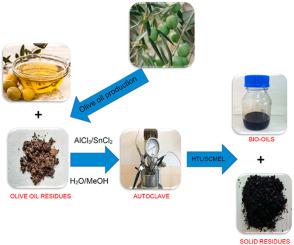Sustainable Chemistry and Pharmacy ( IF 6 ) Pub Date : 2021-06-29 , DOI: 10.1016/j.scp.2021.100476 Tolgahan Evcil , Kubilay Tekin , Suat Ucar , Selhan Karagoz

|
Hydrothermal liquefaction (HTL) of olive oil residues was conducted at various temperatures (250, 270, 300 and 330 °C) and residence times (5, 15, 30, and 60 min). The effect of metal chlorides (AlCl3 and SnCl2) on product yields and compositions was investigated under optimum conditions (300 °C for 15 min). Bio-oil and solid residue yields from the non-catalytic run were 30.8 and 31.8 wt%, respectively. Use of metal chlorides led to decreased bio-oil yields and increased solid residue yields. Experiments were also carried out using methanol, with and without catalysts, and under identical conditions. The bio-oil yield from the non-catalytic supercritical methanol liquefaction (SCMEL) was 33.5 wt%, increasing to 40.3 wt% with AlCl3, however, SnCl2 had almost no effect on bio-oil yield. The heating values of bio-oils from HTL runs were higher than those of corresponding SCMEL runs, and the highest heating value of bio-oil (34 MJ/kg) was obtained with AlCl3. Phenols and ketones were major bio-oil constituents in the HTL runs, whereas esters were the most abundant compounds in bio-oils from SCMEL runs.
中文翻译:

橄榄油残渣的水热液化
橄榄油残渣的水热液化 (HTL) 在不同温度(250、270、300 和 330 °C)和停留时间(5、15、30 和 60 分钟)下进行。在最佳条件下(300 °C 15 分钟)研究了金属氯化物(AlCl 3和 SnCl 2)对产物产率和组成的影响。来自非催化运行的生物油和固体残留物产率分别为 30.8 和 31.8 重量%。金属氯化物的使用导致生物油产量降低和固体残留物产量增加。还使用甲醇在有和没有催化剂的情况下在相同条件下进行了实验。非催化超临界甲醇液化 (SCMEL) 的生物油收率为 33.5 wt%,使用 AlCl 3增加到 40.3 wt% ,然而,SnCl2对生物油产量几乎没有影响。来自 HTL 运行的生物油的热值高于相应的 SCMEL 运行的热值,并且使用 AlCl 3获得了生物油的最高热值(34 MJ/kg)。酚类和酮类是 HTL 运行中主要的生物油成分,而酯类是 SCMEL 运行中生物油中含量最丰富的化合物。


























 京公网安备 11010802027423号
京公网安备 11010802027423号